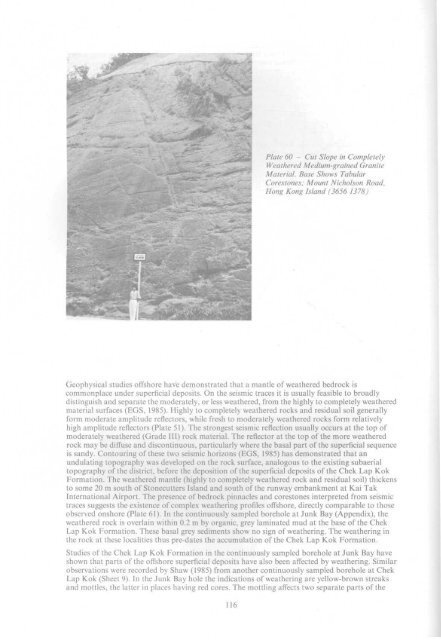Superficial Geology
Superficial Geology
Superficial Geology
Create successful ePaper yourself
Turn your PDF publications into a flip-book with our unique Google optimized e-Paper software.
Plate 60 - Cut Slope in Completely<br />
Weathered Medium-grained Granite<br />
Material. Base Shows Tabular<br />
Cores tones; Mount Nicholson Road,<br />
Hong Kong Island (3656 1378)<br />
Geophysical studies offshore have demonstrated that a mantle of weathered bedrock is<br />
commonplace under superficial deposits. On the seismic traces it is usually feasible to broadly<br />
distinguish and separate the moderately, or less weathered, from the highly to completely weathered<br />
material surfaces (EGS, 1985). Highly to completely weathered rocks and residual soil generally<br />
form moderate amplitude reflectors, while fresh to moderately weathered rocks form relatively<br />
high amplitude reflectors (Plate 51). The strongest seismic reflection usually occurs at the top of<br />
moderately weathered (Grade III) rock material. The reflector at the top of the more weathered<br />
rock may be diffuse and discontinuous, particularly where the basal part of the superficial sequence<br />
is sandy. Contouring of these two seismic horizons (EGS, 1985) has demonstrated that an<br />
undulating topography was developed on the rock surface, analogous to the existing subaerial<br />
topography of the district, before the deposition of the superficial deposits of the Chek Lap Kok<br />
Formation. The weathered mantle (highly to completely weathered rock and residual soil) thickens<br />
to some 20 m south of Stonecutters Island and south of the runway embankment at Kai Tak<br />
International Airport. The presence of bedrock pinnacles and corestones interpreted from seismic<br />
traces suggests the existence of complex weathering profiles offshore, directly comparable to those<br />
observed onshore (Plate 61). In the continuously sampled borehole at Junk Bay (Appendix), the<br />
weathered rock is overlain within 0.2 m by organic, grey laminated mud at the base of the Chek<br />
Lap Kok Formation. These basal grey sediments show no sign of weathering. The weathering in<br />
the rock at these localities thus pre-dates the accumulation of the Chek Lap Kok Formation.<br />
Studies of the Chek Lap Kok Formation in the continuously sampled borehole at Junk Bay have<br />
shown that parts of the offshore superficial deposits have also been affected by weathering. Similar<br />
observations were recorded by Shaw (1985) from another continuously sampled borehole at Chek<br />
Lap Kok (Sheet 9). In the Junk Bay hole the indications of weathering are yellow-brown streaks<br />
and mottles, the latter in places having red cores. The mottling affects two separate parts of the<br />
116

















